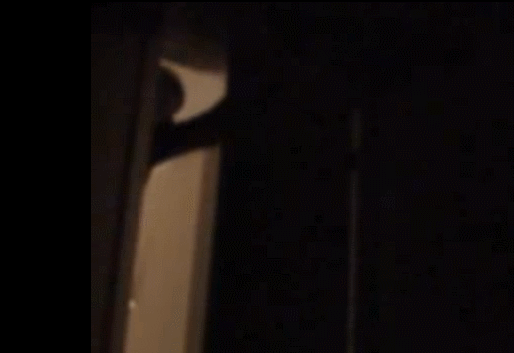Chromatics, "I Can Never Be Myself When You're Around"
What is an album in 2016?

At this point we have to assume that Chromatics’ Dear Tommy is some kind of art project in which the band undermines the very concept of “album” by releasing every track and ancillary part of the promotional material piece by piece over a long period of time while never issuing the volume in question. Whatever. I’ll take my art however I can get it. Here’s another video from Dear Tommy, the “forthcoming” Chromatics “album.” Enjoy.
New York City, September 12, 2016

★★★★★ No one had any objection to the temperature or the character of the air coming into the apartment. Out on the street, leaves and taxi paint and sunglasses lenses gleamed. The mild warmth was unfortunate only in that its mildness made the sweat from riding the defective subway take longer to subside. Cloud shade moved over the streets and across the face of the Empire State Building. In the emphatic shade of late day, someone walked down Fifth Avenue in what looked, from three floors up, like a jacket and scarf.
The Nevada City Wine Diaries
Weingut Berger Grüner-Veltliner, Oyster Bay Sauvignon Blanc, and local Zinfandel

Wednesday
Wednesday was the sort of day where you try to concentrate very hard on your work so as not to dwell on how poorly you will be compensated for it. About a month ago, my boyfriend, Tor, brought his friend Pete over and we drank a 2013 Bella Grace Barbera that Pete thought was fine but a little too fruity and oaky to really love (I totally agreed.) On Labor Day, I ran into Pete and he invited us over, mentioning that he had just bought a case of 2015 Weingut Berger Grüner-Veltliner, nothing super fancy, but he liked it. All day long, all I could think was, “Soon I will be going to Inferno Hot Pilates, and then, basking in my endorphins, drinking Grüner-Veltliner on the porch of a relative stranger.”
After Inferno Hot Pilates, I went to a small, tasteful cheese market in Grass Valley. I told the cheesemonger I would be drinking fairly dry white wine (I felt saying the actual kind would be silly) and asked for appropriate cheese. The cheesemonger asked me questions about my cheese likes and dislikes, but I couldn’t focus. “I care about cheese,” I assured him, “But there’s just no room for it right now.” I tapped the part of head housing the part of my brain in which, under better circumstances, cheese knowledge would have found itself stored.
I ended up with two kinds of sheep’s milks cheese: Perail and Lambchopper—very small amounts of each, because they weren’t cheap, and because no one needs to eat a lot of cheese. “Improve the evening!” the cheesemonger fairly shouted as I accepted the bag, and I smiled back, a big fake smile to mask my utter lack of comprehension. It was only after I was a mile down the road, more genuinely smiling back at my blue heeler Merle’s own panting smile in the rearview mirror, that I realized he had meant that my bringing good cheese would be an evening improver. “Touching,” I said to Merle, “Touching, and perhaps a little awkward?”
Tor had already arrived, and he was slouched down in a wicker chair on Pete’s porch, staring into the darkening valley with a glass of wine resting in his lap, letting hospitality and alcohol work their magic. The liquid in his glass looked so golden and inviting in the light (though the wine is, technically, lighter than golden—what in blind tasting parlance is called “straw”). Pete handed me a glass of my own and we surveyed his view of scrubby manzanita to one side and towering pine trees above and below. We drank to Nevada City, because it was a beautiful night, like most nights here.
The wine was bright and clean and good. Not amazing, but so solidly good. The taste reminded me of how you feel when you make a decision, when you get to that moment of, “Ok, well, I don’t have to worry about THAT anymore.” I felt like I could drink it for a long time and not get tired of it. It didn’t taste like lemons per se, but it had a lemon’s freshness and evoked lemony optimism.
It’s not the fashion to drink white wine really cold, but unless it’s a really super fancy wine — like some $70 bottle of Meursault, my dream — I prefer it that way, and this wine was cold. Pete said it was an accident, because his refrigerator was messed up, and I assured him it was the best thing that had happened to me all day.
A fair percentage of the pine trees in our view were turning brown and dying from a drought-caused plague, and I was glad that this wine was low in alcohol, because after a few sips of a higher-alcohol wine, looking at the brown trees might have made me tear up. Instead, I felt a pleasant, unsentimental distance from encroaching doom, and thought, “Oh, well.”
This Grüner-Veltliner came in a 1000ml bottle so we were all able to have two large glasses. I said I thought maybe all Grüner-Veltliners came in 1000ml bottles but that I might be wrong. I was. Pete told us an astonishing story about someone we both know, and I responded with an even better one, because, for better or worse, this is how people bond. My boyfriend said, “Holy shit,” and I said, “Yeah, that dude’s pretty weird, huh?” and he said. “No, I was just saying holy shit, this wine is delicious.”
Thursday
I was feeling too lazy to bring wine to my friend Karen’s house, plus her mother was there and she puts ice cubes in her wine. I have mixed feelings about putting ice cubes in wine. Actually I don’t have mixed feelings about it at all. I think it’s awful. I have mixed feelings about admitting I think it’s awful because no one wants to be told what they do is awful, so, if you put ice cubes in your wine, fine…except why not just drink vodka and Sprite?
I have brought many, many good bottles of wine to Karen’s house, so when I saw the bottle of Oyster Bay Sauvignon Blanc I gave her a cynical look and said “Really?”, but I was only being mean to make her laugh. Oyster Bay Sauvignon Blanc is a totally fine if unremarkable wine. I will drink a glass of it, but only under very special circumstances might I drink two. It’s light, zingy, with hints of tropical fruit, it’s crisp, but has a slightly canned aftertaste, IMHO. (In case you’re wondering what crisp means: as far as I can puzzle out it at this time it means that a wine is not filled with the oaky caramel toastiness that one associates with Chardonnay but is certainly not exclusive to it. My definition is subject to improvement and enhancement.)
Karen’s mother, a born-and-bred Midwesterner, indeed poured her wine over ice. She refreshed herself liberally and then exclaimed, “I hear you’re going to Japan! Is someone sending you there?” I said I was going to Japan to write something, and that I kept forgetting the precise name of the organization involved but that it had something to do with sake, and then, this sort of lesser known beverage called shochu—
As soon as I said the word “sake” she snapped her fingers and, in a tone that suggested she was on the brink of unravelling a mystery, said, “You know, I just read something the other day, about Japanese soldiers, American Japanese, who fought for the Allies in World War II — they used some word to describe them. I can’t for the life of me remember it — but does your trip have anything to do with them?” I had absolutely no idea what she was talking about, except to assure her that my trip to Japan was most assuredly not being sponsored by Japanese-American World War II veterans.
Afterward, we agreed to play hide and seek with Karen’s two-and-a-half year old, Riley. Riley wanted to hide first. He ran into the living room and stood behind a lamp. After we “found” him, Karen volunteered to hide.
Karen crouched between an ottoman and a wall in the living room, one of five rooms in the entire house. Riley ran through all of them several times. When once again he found himself in the living room, Karen called out “Riley! Riley!” Merle, who rarely barks, ran over to Karen and started to bark at her. Riley just stood there with his mouth open, utterly mystified.
I led Riley around the house by the hand and showed him all the closets and cubbyholes and how the shower had a curtain that one could draw. “These are good places to hide and good places to find people hiding,” I said. He seemed to get it and wanted to hide again. I counted down and shouted “Ready or not, here I come.” Riley lay down on floor right in front of me and put a large stuffed animal over his head.
“Your son is literally the worst hide and seek player alive,” I told Karen. “And your mom thinks all Japanese words are the same.”
She poured herself another tumbler of Oyster Bay Sauvignon Blanc, the only possible response.
Saturday
I found myself, with my friend Sam, at a film festival documentary about people battling the odds against a horrible disease and engaging in a long grueling race to raise money for it.
“I read a study last year that said something like the best time to drink is to get through something you don’t really want to do,” Sam said. “Or something like that.” I decided I had no choice but to purchase a $7 plastic cup of local Zinfandel. I’m not going to say which one, because I don’t really like big Zinfandels and I don’t want to insult one in particular.
Documentaries about people with diseases never sit well with me. Most of them aren’t very good. They’re often not much more than ads to give money to the disease, and why wouldn’t you give money to any other disease? Why wouldn’t they just make an ad? You have to sit there feeling like a monster. What if you had this disease? What if your mom did? What if your kid did? There were kids in the movie with the disease, beautiful children who would slowly lose coordination and then die, unless a cure was found.
I couldn’t stop myself from poking holes in it. “Do you think it’s weird that this race that these two disabled men were in started in Oceanside, right near a big Marine base, and ended in Annapolis — where the Naval Academy is?” I whispered a few minutes in.
“There’s a Q and A,” Sam whispered back. “This is your big chance to demand that two disabled guys explain why they’re participating in the military-industrial complex.”
Local Zinfandels mostly taste like high-quality grape jelly that just so happens to get you drunk. There might be some good ones, but they’d have to have some tannins or acid to temper their juiciness, and this one had neither. There’s a wine expression, “fruit forward.” This wine was not merely fruit forward. It was as if this wine were comprised ten thousand rows of fruit, each of which was jockeying to make it into the front row, and at any given time, most of them were succeeding.
Big wines tend to have a lot of alcohol. After just a few sips, I felt my cynicism bury itself under fermented ripeness, like a hermit crab buries itself in the sand, eyes still warily peeking out. After a few more sips I stopped thinking about single-payer health care and how sentimentality is the helpmate of capitalism. I let local Zinfandel warmth course through me. “Mankind’s struggle against the odds is beautiful,” I whispered to Sam, and he whispered back, “Yes — in all its forms.”
What is Women's Writing?
A Discussion at the Emily Books Symposium

“The idea in publishing used to be that men would never read women’s books, but women would read men’s books,” said Melissa Flashman, a literary agent at Trident Media Group. “I think that’s changing.” Women’s books, she said, are becoming hits on their own, with devoted and enthusiastic readers, and the big five publishing houses are catching on. We were in Liberty Hall, the sleek event space in the basement of the Ace Hotel in Midtown, and a crowd was starting to gather. Women in thick glasses and topknots placed their purses on folding chairs to save their seats; a line grew at the bar. A moment later, Flashman darted away to take her place at the discussion table at the front of the room. She was about to participate in a panel discussion, “What is Women’s Writing?” about the organizing question of the all-day symposium that took place at the Ace this past Saturday, organized by Emily Books.
Emily Books is an online feminist book distributor celebrating its fifth year, founded by Awl pals Ruth Curry and Emily Gould, both accomplished writers in their own right. The crowd at the Ace represented its cult following and increasing industry draw — the audience members who sat crossing their legs under Liberty Hall’s purple lights were predominantly young, white, and female, and everyone had the slightly frazzled air of an editorial assistant who works more than sixty hours a week for less than forty thousand dollars a year. The panel was composed of powerful literary women: Ecco editor Megan Lynch, National Book Foundation director Lisa Lucas, Caroline Casey of the Minnesota-based Coffee House Press, and Laia Garcia, an editor at Lenny Letter.
It was the best kind of intimate conversation: the panelists all got to complain. The question of what women’s writing is quickly turned to one of what women’s publishing is, just as in every industry the content of what women want to say is often eclipsed by the enormous efforts that they have to make just to be heard. The panelists talked about sexism in the workplace, of the dismissal of women’s concerns, of the editorial assumption that femininity and seriousness are mutually exclusive. During a debate about whether or not it was useful for ambitious, intellectual feminists to attempt to infiltrate and change what Gould called “elite cultural arbiter institutions,” Casey snorted. “Those institutions are already ours,” she said. “[Women] are all the people who work there. [Men] are just in charge.” The assistant crowd roared.
The panelists spoke, too, of the enforced differences between men’s and women’s communication, and of their formative moments of realizing that they could not or would not be allowed to talk the way that men do. “A man will say, ‘I’m going to do this,’ while a woman will say, ‘I hope to do this,’ said Lynch, speaking to the ways that women can be more cautious in their speaking than men, how they are careful not to seem too sure of themselves. “I didn’t realize until college that girls were supposed to be a certain way around men, to make them feel good about themselves,” Casey said. “Your male friends don’t want to hear about your period.” Lynch reasoned that “a conventionally feminine communication style can actually be a very effective way of getting what you want.” This might be true, but it’s still a concession to the grim idea that the easiest way for a woman to get what she wants is to convince a man that something was his idea.
Ultimately the group was enthusiastic, agreeing that the failures to accommodate women’s perspectives in publishing was eclipsed by the beauty of readers’ desire for them. Garcia talked about her dog eared copies of Chris Kraus’ I Love Dick and Kate Zambreno’s Heroines, two books that merge theory with frank memoir. “There’s been a privileging of emotional resonance,” in fiction, Flashman said. “Women readers want emotional depth at every level of the fiction market, whether they’re getting their book recommendations from People magazine or Instagram.” Several panelists cited the role of social media in creating a more active and connected market of women readers, who are able to discuss and recommend books with greater ease than ever before.
Garcia spoke of formative early experiences reading excerpts of feminist tracts on Tumblr; Lucas cited the hashtag #FeminismIsForWhiteWomen as opening up a conversation about exclusion, in fiction and elsewhere. “There’s a demand for more work by women of color that is not only about race, that depicts whole lives,” she said. “There’s more or a marketplace for it.” When Casey mentioned that Elena Ferrante had used the domestic sphere as a way to write about politics, all of the women nodded, almost in unison.“There’s been a change in what subject matter, perspective, and scope is appropriate for a literary novel,” Lynch said. At the beginning of the night, Curry and Gould had said that their aim with Emily Books was to help create a literary world that was more accessible to those who were not “white, heterosexual, and male.” The women’s testimonies suggested that slowly, that world is becoming more real.

After the panel disbanded there was a cocktail hour, and women moved through the narrow aisles between the chairs; they bumped tote bags passing back and forth from the bathroom and stood in small clusters taking enthusiastically, clutching clear plastic cups of wine. Then everyone settled back down for a series of readings by Emily Books authors. Eileen Myles wore a Kelly green tee shirt and read a passage about a trip to Ireland from a forthcoming book; Natasha Stagg read a dark, funny passage about the beginning of a stalking relationship from her Semiotexte-published novel, Surveys. The poet Ariana Reines wore a dress painted with a scene of city buildings on fire. When she stood up to read, she said by way of introduction, “I’m going to read a love poem really fast.” The poem included the line, “I used to think the defining characteristic of a writer was not wanting to have her picture taken, ever.” Everyone in the audience chuckled; some of the women held up their phones for a photo.
The Creepiest Series On YouTube
The making of “Marble Hornets,” a horror series with over 80 million views

It was a muggy June evening in 2009 and Troy Wagner was bored as hell. The twenty-one-year old film student was home from the University of Alabama for the summer, and he spent much of it trawling the forums of Something Awful from his childhood bedroom. Wagner’s mother implored her son to get a job, but nothing had turned up. Instead, he found himself engrossed by a thread dedicated to creepy Photoshop work on the then-popular comedy site.
Wagner noticed that one particular post from a user named Victor Surge was getting a lot of attention. It featured two black-and-white photographs, each depicting a tall, faceless figure in a suit, its distended, tentacle-like arms resting on the shoulders of children who seemed unaware of his presence. “We didn’t want to go, we didn’t want to kill them, but its persistent silence and outstretched arms horrified and comforted us at the same time,” one of the captions read, citing the photographer as “unknown, presumed dead.”

Wagner’s engagement on this thread would indeed get him a job, albeit a fairly nontraditional one as far as summer jobs go. Within weeks, Wagner would found a film studio to distribute a web series he and a childhood friend created, which quickly and unexpectedly garnered a cult following. Before long it would be well on its way to becoming one of the most successful — not to mention creepy — YouTube series of all time.

What Wagner witnessed on Something Awful that June evening was the birth of Slender Man, the internet horror icon. Today, Slender Man is a regular fixture on Creepypasta and other horror sites, the subject of innumerable fan fiction spinoffs and a feature-length film, and even inspired a few Milwaukee tweens to attempt a brutal murder in 2014. But in 2009, Slender Man’s existence was unknown outside of a small community of web users who took delight in crafting the legend behind this faceless beanstalk of an entity.
As the legend ballooned via text, image, and sound contributions from Something Awful users in the days following Surge’s initial post, Wagner saw an opportunity to put his knowledge of film into practice. So he called his friend and fellow film student Joseph DeLage, whom he had known since sixth grade, and who was also unlikely to be doing anything all that important over the summer.
DeLage came over that same evening and the two aspiring filmmakers whittled away the night by writing scenes they thought would be fun to shoot on a stack of notecards. There was little coherent plot to their ideas, and the only real guiding principle was the outline of the Slender Man myth being sketched in real time on the web. By the end of the night, they had a season’s worth of loosely related material and spent the next few days filming.
On June 20, just ten days after Victor Surge’s original post, Wagner and DeLage uploaded an introduction to their project on YouTube — and “Marble Hornets” was born.

“Marble Hornets” follows the story of Jay (played by Wagner), a twenty-something who has come into possession of a large collection of videotapes previously belonging to his friend Alex Kralie (played by DeLage). Three years prior, Alex had abandoned his student film project Marble Hornets for unknown reasons. He became increasingly reclusive, and before he totally disappeared, Alex gave his tapes to Jay and instructed him to never discuss their content with him.
As Jay begins working his way through Alex’s tapes in an attempt to discover what made his friend abandon his pretentious film project, he starts uploading the footage to YouTube as the short entries that compose “Marble Hornets.” It quickly becomes clear that Alex’s project was being interrupted by an entity known as the Operator — the series’ take on the Slender Man. As Jay probes deeper into Alex’s tapes, the Operator begins haunting Jay, prompting him to set up cameras in his house and uploading this footage as “Marble Hornets” entries as well.
Jay’s YouTube activity eventually draws the attention of totheark, a user who posts cryptic and often threatening responses to Jay’s “Marble Hornets” entries. Totheark functions as both a character in the story and the bridge between “Marble Hornets” as a film and an alternate reality game: each of totheark’s video posts contains a hidden message teasing a forthcoming episode in the series. By the close of the first season of “Marble Hornets,” totheark’s stalking behavior intensifies to the point where he makes an attempt on Jay’s life, Jay has his first run-in with the Operator and Wagner offers his 36,000 subscribers far more questions than answers.
“In the first season there isn’t a whole lot of organization going,” explained Wagner. “[DeLage and I] thought it would be this little thing that maybe a dozen people would see, but once we got to season two we were like ‘Oh crap, we actually have to make a story’ because too many people were watching it.”
By the time “Marble Hornets” concluded in 2014, five years to the day after Wagner and DeLage uploaded their original intro video to YouTube, the series had amassed some 80 million views over 92 episodes, tens of thousands of additional followers, a lively subreddit, and its own feature-length film. The series’ appeal is obvious: it’s a stellar example of the found-footage genre of horror popularized by The Blair Witch Project well over a decade earlier, and builds upon it by adding elements of dream logic and bizarro horror more typical of a Lynch or Cronenberg film.

Even after several viewings, “Marble Hornets” is difficult to watch alone in the dark, a welcome reminder in the age of cheap scares that horror films don’t have to suck. The truly amazing thing about the film is that it was all done on a budget that Wagner estimates to have been about “zero dollars,” which often required the cast and crew to get creative with their special effects, especially when it came to scenes which involved things like lighting a house on fire.
“Joseph [DeLage] and Tim [Sutton, a cast member] were actually living in that house at the time,” recalled Wagner. “It was a real fire and we were very safe about it — or at least as safe as you can be without hiring a pyrotechnic person. We were only going to do one shot with it and use whatever we got.”
The guerilla approach to filming exemplified in this scene largely defines the overall aesthetic of “Marble Hornets,” in which many of the scenes were shot in abandoned buildings without permission and the vast majority of the dialogue is improvised. But this fast and loose approach doesn’t detract from the overall horror of the project — if anything, it adds to it by unintentionally creating vacancies. “People fear the unknown and if you leave a blank for people, they’ll fill it in with the thing that makes them the most uncomfortable or the most scared,” said Wagner. “You will never be able to scare 100 percent of the people with one thing because what’s scary to people is usually pretty subjective. You’ll never be able to make something that is scarier than what is in someone’s head.”
For Wagner, this is largely what makes Slender Man such an accessible horror icon — its featureless face is quite literally a blank slate and allows anyone to project their deepest fears onto it. This also accounts for the innumerable permutations of the Slender Man character on the internet, which are often united by only a few core, ‘canonized’ character traits. And much of the Slender Man cannon, such as the entity’s ability to distort audio/visual outputs and induce ‘slender sickness’ in its victims, was created in “Marble Hornets.”
One of the defining features of “Marble Hornets” is its ability to blend the line between fiction and reality — indeed, the Buzzfeed article that first brought attention to the series was headlined: “Marble Hornets: Real or Hoax?” While the fact-or-fiction element certainly added a layer of suspense to the film, when two twelve-year old girls tried to brutally murder their friend in 2014 in an effort to become ‘proxies’ of the Slender Man, Wagner and his co-creators discovered this blade cut in both directions. According to Wagner, the idea of the Slender Man’s proxies — children who come under the entity’s sway to do its bidding — wasn’t started by “Marble Hornets.” Although proxies play a central role in the film, the idea for this Slender Man character trait actually belongs to Tribe Twelve, another Slender Man inspired web series.
“Looking at the girls’ reasoning for [the stabbing], I could tell that they weren’t really familiar with us,” said Wagner. Still, they received a lot of attention in the aftermath. “Our emails were flooded and people were calling us left and right,” said Wagner. “One of the magazines, I think it was People, actually found Joseph’s grandparents’ phone number and called them looking for him. So we immediately adopted a rule that we would not benefit from this in any way.”

Their refusal to profiteer on some fucked-up real-life events didn’t dampen the impact of the series, which had achieved its own escape velocity. By season 2 of “Marble Hornets,” the series was getting so many views that Wagner and DeLage founded a production company and turned it into a full time job. When it came time to produce the third and final season of the series, Wagner and his co-creators launched a Kickstarter in the hopes of raising $8,000 for materials and a DVD pressing. By the time the Kickstarter was finished, they had raised $72,000.
The popularity of the web series inevitably gained the attention of Hollywood: near the end of the third season, Wagner and DeLage were offered a deal for a feature-length film. In essence, the deal was that the film would take place in the “Marble Hornets” reality, but with different characters. Wagner and DeLage would have minimal creative input (although they did manage to convince director James Moran to cast renowned contortionist/sci-fi actor Doug Jones as the Operator), but were still kept in the loop during the film’s development.
The end result was Always Watching: A Marble Hornets Story, released in early 2015. Given the success of the series it was based on, the film was surprisingly but universally trashed by critics. Although Wagner didn’t personally hate the film, he does think it veered a little too far from its original premise.
“I felt like [Always Watching] was very loosely based on ‘Marble Hornets,’ which is what we told them when we got the script,” said Wagner. “People liked the pacing of the web series better because it’s able to have this slow build that an hour-and-a-half movie doesn’t have the luxury of. I don’t think ‘Marble Hornets’ could’ve existed as anything other than a web series.”
After the conclusion of the series, Wagner began working on a spinoff called “Clear Lakes 44” which went on hiatus last April after a series of internal disagreements in Wagner’s production company which resulted in many of the original members leaving. Wagner ended the production of “Clear Lakes 44” before it really had time to establish itself as a series and its relationship to the “Marble Hornets” universe remains unclear.
Many “Marble Hornets” fans were bummed that the follow-up series ended before it really had a chance to start and so far there is little indication that more episodes will be produced. But ultimately that’s probably a good thing. As the dismal failure of Always Watching already demonstrated, “Marble Hornets” is a series that defies imitation and reproduction. It’s a relic from a time when the internet was on the cusp of the total takeover of newsfeeds and karma, yet niche forums were still able to foster a sense of community which could inspire passion projects like “Marble Hornets.” The webscape of 2009 seems almost alien today, but the ability of “Marble Hornets” to horrify its audience remains, our goosebumps serving as a testament to the enduring force of its themes in the information age.
The Slender Man in “Marble Hornets” is a cybernetic horror of technical ambiguity and uncertainty. Its blank face is simultaneously everywhere and nowhere, its motives are unclear, its influence is total, and its presence is only discernable in audio static and video distortion — the breakdown of technical function. Like everyone online, Slender Man straddles the analog/digital divide, at once a product of both cyberspace and material culture.
Perhaps this is why Slender Man is such an accessible horror icon. In a time defined by fear and uncertainty about increasingly sophisticated internet technologies like self-driving vehicles, the failure of digital technologies can indeed be deadly. We are driven to digitally record and disseminate the minutiae of our daily lives on Snapchat, as if some coherent explanation for what is happening around us might emerge from the pixels; and in post-Snowden world, it’s impossible to shake the feeling that someone is always watching.

The persistent question in “Marble Hornets” — whether the Operator actually exists — also haunts our day-to-day existence. We are left to wonder whether it is more horrifying to find ourselves at the mercy of a faceless, omnipresent entity who remotely controls every aspect of our lives, or to discover that there is no driver at the wheel to blame for our actions. Ultimately “Marble Hornets” leaves this question for the viewer to resolve, but Wagner and his co-creators seem keenly aware that the only satisfactory response is to just keep telling yourself that everything is fine.
Daniel Oberhaus is from Phoenix, Arizona, which isn’t nearly as bad as it sounds. You can find him on Twitter.
Róisín Murphy, "Whatever"
It’s up to you but you should probably like this album more.

In no way has Róisín Murphy’s Take Her Up To Monto received the accolades it deserves, which is surely a result of its unabashed weirdness. Here’s one of the most accessible songs on the album, so if you have been hesitant about it thus far it’s a good place to dip in a toe and test the waters. The waters are fine! Enjoy.
I'd Rather Be Alone Forever Than Ever Have to Spend an Afternoon Helping Choose Paint Colors for...
I’d Rather Be Alone Forever Than Ever Have to Spend an Afternoon Helping Choose Paint Colors for the Guest Bathroom
And other answers to unsolicited questions.

“I don’t have an NFL football team. Who should I cheer for?” — New Fan Fran
When I first realized I could spend my weekend mornings watching World Football from Britain, Spain, Germany and Italy I knew I would need teams to cheer for. I grew up in Massachusetts, so I already had a hockey team, a basketball team, a baseball team and an American football team. And that’s not counting the local New York area teams I follow. How does one select something as important as a soccer team?
The short answer is just pick the team whose uniforms you like the best. I decided to follow Tottenham Hotspur. I liked their uniforms, a sort of classy white and blue with yellow accents. They had a tall striker and a short striker. Their stadium was old and cool-looking. And they hadn’t won anything in a long time. Those people who start cheering for a team five minutes before they win a Super Bowl are unbearable. You can cheer for winning teams lightly when your real team is out of it. I always have to have a team to cheer for or else watching TV sports is no fun. Someone has got to lose so someone else can win.
So Tottenham Hotspur. They had a cool cockerel as a mascot. Their fans sing a cool version of “When the Saints Come Marching In”: “When the Spurs Come Marching In!”
I’ve liked them ever since. They’ve always been pretty good, in the Top 8 or so teams. Last year they came in 3rd. Pretty good. Never select a team with a history of hideous losing. There is no reason to inflict that on yourself. This is sports, it’s supposed to be fun. As fun and as satisfying as it must have been for long-suffering fans when the Cleveland Cavaliers win the NBA Championship, what led up to them winning was not fun. And as cool as you might think the Cleveland Browns uniforms look, I wouldn’t jump on that moving crazy train just yet.
I cheer for Palermo in the Italian league because my grandmother was from Sicily and they have cool pink and black uniforms. I cheer for Cologne in the German league because they have an awesome goat logo. I met these guys from Bordeaux a while back, so I will always love Bordeaux anything. I’m still trying to decide on a Spanish football team. There are only like 3 good teams that win all the time. So I haven’t decided.
American Football has the same once a week Big Game quality as soccer. So focus on:
- Best Uniforms
- Not Completely Jinxed
- Team Hasn’t Just Won It All
And, remember, watching sports is supposed to be fun. If you live near a bar that cheers for the Pittsburgh Steelers, maybe cheer for the Steelers. You can meet a new bunch of pals and have some laughs while our world crumbles. It’s what Tom Brady wants for us all.


“Is it really better to have loved and lost than never to have loved at all?” — Heartbroken Hal
Yes. In fact, it’s better to have loved and lost than to actually be in love. I prefer just having crushes on people, however long they last. Crushes are great. And real love is hard. You have to really work at real relationships, and who really has the time to do all that now that porn is free and gotten at the stroke of a few keys? Sure, companionship is nice. But that’s what I got my roommate Ben for. He is recovering nicely from his knee surgery. And I bring him home popsicles.
The longest crush of my life lasted ten maybe years. That’s a pretty good stretch of me just kind of unrequitedly loving someone who was kind of aware of it, not too bothered but not too interested, either. I’ll sit at home writing poems for someone and then, you know, watch hockey.
Losing someone is really the only way you really know if you’re in love, any way. And you can tell you’re in love because you feel miserable. And that’s what love is. Feeling miserable. Always having to say you’re sorry (which movie said that love “Was never having to say you’re sorry?” Because fuck that movie). All that Hollywood movie stuff about what love is? That’s cool and all, but love is really about doing day to day crap no Hollywood movie would ever want to film anyone doing, like cleaning things and remembering anniversaries.
The most satisfying relationship I’ve ever had was being snowed in with a house guest and never doing anything physical, just watching old movies by candlelight and getting matching tattoos. I wasn’t in love with her, I was in love with the character I made out of her. And it was delightful for a weekend, unsustainable for a lifetime and who wants kids anyway? I’d rather be a lonely old grump waiting for a ball game to come on any day.
Sex is OK once in a while. But just longing and longing for someone who probably isn’t even worth it? That’s where the fun is really at. Do yourself a favor and get as comfortable as you can being single. Then you’re actually thrilled by the small encounters you get and are single enough to take advantage of them.
Oh, and never grow up. That’s a bad deal.
Jim Behrle lives in Jersey City, NJ and works at a bookstore.
New York City, September 11, 2016

★★★★ Rigging ropes swayed outside; contrails feathered into intersecting clouds. The old day’s heat had been so stuffy it seemed to call for air conditioning, but the breezes coming in were cool and clean enough to induce panic about the limited hours in the day, the limited unknown number of days beyond it, while the four-year-old demanded to play indoors with Legos and the nine-year-old stalled his way through practicing the viola. Outside it was warm enough to raise a sweat in the crook of the elbow that held the phone full of people arguing about how warm the day was. A woman argued with her child about whether it was too hot for him to set up his car-crashing game in the unshaded part of the playground. The sunset was pink-streaked and lovely but grimly early.
Sing This Not That
Better Karaoke For One and All
by Karen Corday and Sarah Howard Parker

Karaoke is a team sport; your audience is just as important as your performance. If this weren’t the case, we’d all just be singing into hairbrushes in the privacy of our own bathrooms. We’re not talking about audience participation, although that has its place and is often useful, but rather audience appreciation.
In order for your audience to appreciate your song choice and execution, you must appreciate their time and attention enough to offer something more than the usual standards. With all of this in mind, we have put together a few suggestions to ensure a wonderful evening for all involved. Now, go get your slips in and tip your hosts and bartenders!

Don’t Sing This
“Paradise by the Dashboard Light” — Meat Loaf
Do Sing This
“Don’t You Want Me” — The Human League
No offense intended to Mr. Loaf, but songs this long are an act of karaoke aggression that no one should tolerate any longer. It’s also a good rule of thumb to avoid anything written by Jim Steinman. (This is not his only entry on this list!) You want to do a funny duet about a stale relationship that’s not a ballad? Try “Don’t You Want Me.” This song should be overdone by now, but it’s surprisingly underused, and the audience might sing along with the WHOA-OH-OH-OH part, which is very heartening and encouraging. Speaking of karaoke aggression…
Don’t Sing This
“Bohemian Rhapsody” — Queen
Do Sing This
“Don’t Stop Me Now” — Queen
“Don’t Stop Me Now” has a slow-fast-slow structure like “Bohemian Rhapsody” with the added bonus of also being by Queen while not having been heard a thousand times before by everyone in the room. It’s an action-packed three and a half minutes long, as opposed to seventeen years long. No one is happy to see someone vault up to the microphone for a seventeen-year-long stay. Don’t be greedy. Finally, “Don’t Stop Me Now” contains the line “I am a sex machine ready to explode!” and that is more fun to scream out in triumph than “Scaramouche, scaramouche, can you do the Fandango?” Try it!
Don’t Sing This
“Summer Nights” — the cast of Grease
Do Sing This
“Nothing’s Gonna Stop Us Now” — Starship
You may think “Summer Nights” is a crowd pleaser, but we assure you that the crowd will be 200% more pleased to hear anything else! Is it a flirty, cheesy duet you’re looking for? If so, look no further than the love theme from Mannequin. You get all of the nostalgia value and none of the awkward lyrics and pelvic thrusts! And who doesn’t love the idea of Andrew McCarthy and Kim Cattrall (in mannequin form) riding off on a motorcycle into the sunset? Waaaay more romantic than two middle-aged “kids” making out under a dock until 10:00.
Don’t Sing This
“What’s Up” — 4 Non Blondes
Do Sing This
“Torn” — Natalie Imbruglia
There are better ways to tap into 90’s grrrly angst than channeling Linda Perry and her ridiculous hat. “Torn” gives off a similar decidedly brunette vibe without trying (and probably failing) to get up that great big hill of hope…for a destination. It also has the advantage of being a slightly unusual choice that will still elicit a strong emotional response from your audience. Further options from this genre include anything by Garbage, The Cranberries, or any other 90’s female-led band named for a noun.
Don’t Sing This
“Total Eclipse of the Heart” — Bonnie Tyler
Do Sing This
“Alone” — Heart
Power balladeer Jim Steinman rears his leonine head again for the second time on this list. With TEotH, you will inevitably have someone (possibly the karaoke host) acting as “Bright Eyes” and they either will or they won’t turn around. Why risk it? You also may think it’s a clever choice to insert salacious language into this song to make it funnier; you are wrong. Let’s avoid both of these scenarios entirely in favor of the far superior “Alone,” which is an excellent, beloved song that still gives you plenty of room to bring the a little bit gothic/a little bit hair metal drama.
Don’t Sing This
“Don’t Stop Believin’” — Journey
Do Sing This
“Can’t Fight This Feeling” — REO Speedwagon
“Don’t Stop Believin’” has had its day and then some. May we suggest moving over to the arena next door where REO Speedwagon will take care of your bombastic, triumphant needs? Just look at those adoring faces in the audience when you clench your fist with sincerity and purpose and sing about bringing that ship into the shore and throwing away the oar forever. Isn’t that a better transportation metaphor than the tired old midnight train going anywhere?
Don’t Sing This
“Piano Man” — Billy Joel
Do Sing This
“Bennie and the Jets” — Elton John
NOW PAUL IS A REAL ESTATE NOVELIST/WHO NEVER HAD TIME FOR A WIFE/AND HE’S TALKING WITH DAVY/WHO’S STILL IN THE NAVY/AND PROBABLY WILL BE FOR LIFE/OH LA LA LA DI DA DA/LA LA DI DA DA DA DUM…(cue audible sobbing)
This song moves quickly from cheerful swaying with drinks in hand to morose reflection on the brutal reality of giving up on one’s dreams and drowning one’s resultant sorrows with a bunch of other sad-sack drunks. BILL, I BELIEVE THIS IS KILLING ME. It’s too real. May we suggest “Benny and The Jets” as an alternative? It is just as instantly recognizable and timeless as “Piano Man” without the violent mood swings. Plus if you feel insecure about your lack of singing prowess, you can sing it in the style of Biz Markie. Speaking of The Biz…
Don’t Sing This
“Baby Got Back” — Sir Mix-A-Lot
Do Sing This
“Just A Friend” — Biz Markie
This one speaks for itself and no further explanation is necessary.
Don’t Sing This
“I Want It That Way” — Backstreet Boys
Do Sing This
“Summer Girls” — LFO
Look, we can’t believe we’re suggesting this either, but the wacky, OMG remember THIS?!?! reaction you want for your Backstreet Boys throwback isn’t going to live up to your expectations. Everyone in the room has heard IWITW so many times that it’s like elevator music at this point. “But what about that hilarious scene from Magic Mike XXL?!” Yeah, what about it? Are you going to tear open a bag of Cheetos and rain them down upon the most absurd abs in the history of torsos? No? Then do “Summer Girls,” sing about Chinese food making you sick and girls wearing Abercrombie and Fitch, and bask in the late-90’s frosted tips nostalgia-induced adoration you crave and deserve.
Don’t Sing This
“Livin’ on a Prayer” — Bon Jovi
Do Sing This
“Praying for Time” — George Michael
There’s no obvious connection here besides prayer. This George Michael song is so beautiful, though. Just sing it. Someone in the audience won’t have heard it in 25 years and they will clasp their hands to their chest in a dramatic fashion when you start to sing.
Don’t Sing This
Any song from a musical or a Disney movie
Do Sing This
“Super Trouper” — ABBA
ABBA is basically perfect for any occasion. And you know what, you can pretend it’s from a musical, because it’s in Mamma Mia. Or, for a deeper cut, you can get really crazy and go with Murray Head’s “One Night in Bangkok” from the musical Chess, scored by the men of ABBA. What we’re saying is if you are desperate to sing something from a musical, consider something with an ABBA tie-in.
Don’t Sing This
“I Will Survive” — Gloria Gaynor
Do Sing This
“Fame” — Irene Cara
At first I was afraid…to mention this song. Kept thinking I could never…find a suitable replacement. But then I spent…about 5 minutes pondering it and realized this Irene Cara favorite has everything you need and more, including potential audience participation and interpretive dance moves. And I grew strong…in my recommendation, which I hope you will accept.
Don’t Sing This
“My Way” — Frank Sinatra
Do Sing This
Literally anything else
Beyond cruelly forcing your audience to muffle yawns and eye rolls when Ol’ You Eyes takes the stage, keep in mind that there is an actual death curse associated with this song. Please be safe and live to sing another day.
Karen Corday writes, works, lives, eats, drinks, naps, and sings poorly but with great enthusiasm in beautiful Western Massachusetts. She rightfully lost the lead in every high school play to her co-author.
Sarah Howard Parker began her karaoke career around the same time she pretended to have an English accent for several weeks. She would like to thank her co-author for putting up with her during that time. She is now fretting about her song choices in Cambridge, MA.

